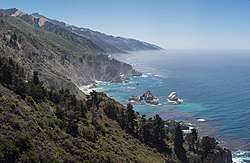Point Lobos Ranch
Point Lobos Ranch is an 1,315 acres (532 ha)[1] parcel of land in the northern region of Big Sur, California, United States. It is owned by the California State Park System which since acquiring the land in 2001 has stated that the land is being held for possible use as a state park.
Point Lobos Ranch is located south of Carmel by the Sea and east of Point Lobos State Reserve. It contains one of the world's largest stands of native Monterey Pines, endangered Gowen cypress, and rare maritime chaparral plant community.[2]
History
The Ohlone people harvested shellfish including abalone from the waters around Point Lobos. Evidence has been found of seasonal camp sites on the San Jose Creek for about 2,500 years. The village, named Ichxenta, was occupied until the end of the Carmel Mission era, when the native population was decimated by disease and forced assimilation. In about 1770, Spanish Vaqueros from the nearby Carmel Mission ran cattle on Point Lobos.[3][4]
Governor Juan Alvarado granted two square leagues of land named Rancho San Jose y Sur Chiquito in 1839 to Marcelino Escobar. It was briefly owned in turn by Doňa Maria Josefa de Abrego, who may have held it for her husband, Monterey Alcalde José Abrego. In 1843, Doňa Abrego deeded the land to a group of about 10 soldiers from the Monterey Presidio. It appears that the soldiers paid nothing, and a legend attached to the transfer says a gambler lost a rancho in a card game.[5] On June 7, 1844, the soldiers turned the Rancho over to their superior officer, Colonel José Castro, former Governor Alvarado's brother-in-law.[6]
When Mexico ceded California to the United States following the Mexican–American War, the 1848 Treaty of Guadalupe Hidalgo provided that the land grants would be honored. But the Land Act of 1851 required owners to prove their ownership, and Castro filed a claim for Rancho San Jose y Sur Chiquito with the Public Land Commission in on February 2, 1853.[5] While waiting for his case to be decided, Castro sold his 8,876 acres of land in 1854 to Joseph S. Emery and Abner Bassett for $700, leaving to them the legal fight for ownership.[6][7] The litigation lasted for 38 years, during which thirty-two others eventually asserted that they owned a portion of the land. Thirty-five years later, in 1886, Castro's successors finally obtained clear title, forcing all other claimants out.[8]
In 1874, a seam of low grade bituminous coal was found in upper Malpaso Canyon.[9] On September 6, 1888, shortly after the patent for Rancho San Jose y Sur Chiquito was approved, almost all of the claimants banded together to form the Carmelo Land and Coal Company.[10][5] But by 1896, the coal mine was unprofitable.[5]
In 1862, Antonio Victorine, a Portuguese whaler from the Azores, arrived at Point Lobos, following the whale population. Other whaler's from the Azores followed him. Some built cabins on land east of Point Lobos, and old houses on the ranch property still bear Portuguese names, like Victorine and Morales.[11][12]
Alexander MacMillan Allan, a successful race track architect and real estate developer from Pennsylvania, purchased 640 acres of Point Lobos from the Carmelo Land and Coal Company in 1898. He preserved Point Lobos and established the Point Lobos Dairy at the mouth of San Jose Creek which was operated from 1903 until 1954.[6]
Acquisition
The land was acquired by the Big Sur Land Trust in 1993 for $4.25 million.[13] It held onto the land until 2003, when it sold the land to California State Park System for $3 million in funds from Proposition 117 funds and a $1 million grant from the Coastal Conservancy.[14][13][15] Although owned by a public agency and purchased with public funds, the public is not allowed to access the property.[16]
In popular culture
Point Lobos Ranch was seen in an episode of Bay Area Backroads.
External links
References
- "Regional Park District to Acquire Whisler-Wilson Ranch from Big Sur Land Trust". Monterey County Weekly. 2012. Retrieved December 5, 2016.
- "Point Lobos Ranch Park Property".
- Wiley, Marlene. "Point Lobos State Reserve". www.mnn.net. Retrieved 7 May 2018.
- "History". www.pt-lobos.com. Retrieved 7 May 2018.
- Aubrey Drury, 1954, Point Lobos Reserve, California State Park, Department of Natural Resources, Sacramento, p. 78–85
- The Whaler's Cabin and The Whaling Station Museum (PDF), Point Lobos Foundation, 2017
- Hoover, Mildred B.; Rensch, Hero; Rensch, Ethel; Abeloe, William N. (1966). Historic Spots in California. Stanford University Press. ISBN 978-0-8047-4482-9.
- "Report of the Surveyor General 1844–1886" (PDF). Archived from the original (PDF) on 2009-05-04.
- Walton, John (2003). Storied Land: Community and Memory in Monterey. Berkeley, Calif.: University of California Press. ISBN 978-0-520-22723-1. Retrieved 7 May 2018.
- "The Allan Memorial Grove at Point Lobos State Reserve" (PDF). California State Parks. 2004. Retrieved 7 May 2018.
- Grimes, Teresa; Heumann, Leslie (January 7, 1997). "Historic Context Statement Carmel-by-the-Sea". ci.carmel.ca.us. Retrieved 30 December 2017.
- Schmalz, David. "Point Lobos Ranch was once set to become a subdivision". Monterey County Weekly. Retrieved 10 May 2018.
- "The Big Sur Land Trust is trying to buy paradise". Monterey County Weekly. December 13, 2001. Retrieved October 24, 2016.
- "Big Sur Land Trust Sells Whisler-Wilson Ranch to Monterey..." Big Sur Land Trust. Retrieved 10 May 2018.
- "Our response to California State Parks Preferred Alternative". Big Sur Land Trust. Archived from the original on 2017-11-07. Retrieved 2017-10-31.
- Trust, Big Sur Land. "Landscapes (Big Sur Land Trust)". Big Sur Land Trust. Archived from the original on November 7, 2017. Retrieved December 6, 2016.
